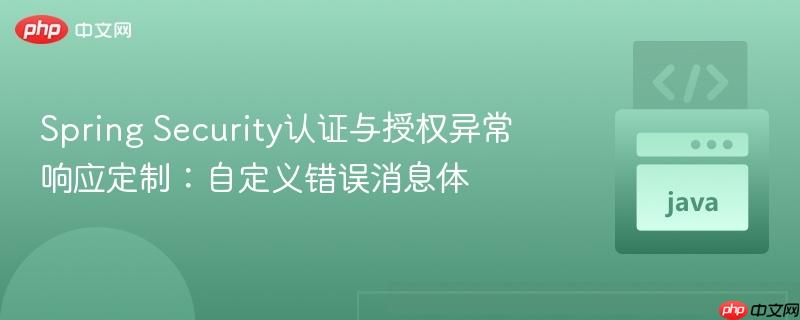
本文探讨了spring security过滤链中认证与授权失败的异常处理机制。针对全局异常处理器无法捕获此类问题的场景,我们介绍了如何通过实现自定义的`authenticationentrypoint`和`accessdeniedhandler`来拦截并定制http响应体,特别是提供json格式的错误信息,以提升用户体验和api一致性。
在Spring Boot应用中,我们通常会使用@ControllerAdvice和@ExceptionHandler来构建全局异常处理器,统一处理控制器层抛出的各种异常,并返回结构化的错误响应。然而,当异常发生在Spring Security的过滤链中时,例如认证失败(AuthenticationException)或授权失败(AccessDeniedException),这些全局处理器往往无法捕获并处理。
这是因为Spring Security的过滤链在请求到达控制器之前就已经执行。当认证或授权失败时,Spring Security会通过其内部机制(如ExceptionTranslationFilter)来处理这些异常,并可能直接设置HTTP响应,例如在WWW-Authenticate头中提供错误信息,而不是将异常抛到控制器层,从而绕过了@ControllerAdvice。为了在这种情况下定制响应体,我们需要利用Spring Security提供的特定接口。
Spring Security提供了两个核心接口来处理过滤链中的认证和授权异常:
通过实现这些接口,我们可以在Spring Security处理这些异常时介入,并完全控制HTTP响应,包括设置状态码、响应头和响应体。
当用户未认证或认证失败时,AuthenticationEntryPoint是进行响应定制的关键。我们可以实现一个自定义的AuthenticationEntryPoint来返回JSON格式的错误信息。
示例代码:自定义RestAuthenticationEntryPoint
import com.fasterxml.jackson.databind.ObjectMapper;
import org.springframework.http.HttpStatus;
import org.springframework.http.MediaType;
import org.springframework.security.core.AuthenticationException;
import org.springframework.security.web.AuthenticationEntryPoint;
import org.springframework.stereotype.Component;
import javax.servlet.ServletException;
import javax.servlet.http.HttpServletRequest;
import javax.servlet.http.HttpServletResponse;
import java.io.IOException;
import java.util.HashMap;
import java.util.Map;
@Component
public class RestAuthenticationEntryPoint implements AuthenticationEntryPoint {
private final ObjectMapper objectMapper = new ObjectMapper();
@Override
public void commence(HttpServletRequest request, HttpServletResponse response,
AuthenticationException authException) throws IOException, ServletException {
// 设置HTTP状态码为401 Unauthorized
response.setStatus(HttpStatus.UNAUTHORIZED.value());
// 设置响应内容类型为JSON
response.setContentType(MediaType.APPLICATION_JSON_VALUE);
// 设置字符编码
response.setCharacterEncoding("UTF-8");
// 构建JSON错误响应体
Map<String, Object> errorDetails = new HashMap<>();
errorDetails.put("status", HttpStatus.UNAUTHORIZED.value());
errorDetails.put("error", "Unauthorized");
errorDetails.put("message", "认证失败或未提供有效的认证凭证: " + authException.getMessage());
errorDetails.put("path", request.getRequestURI());
// 将错误详情写入响应体
objectMapper.writeValue(response.getWriter(), errorDetails);
}
}配置Spring Security使用自定义AuthenticationEntryPoint
在Spring Security的配置类中,我们需要将自定义的RestAuthenticationEntryPoint注册到HttpSecurity对象中。
import org.springframework.context.annotation.Bean;
import org.springframework.context.annotation.Configuration;
import org.springframework.security.config.annotation.web.builders.HttpSecurity;
import org.springframework.security.config.annotation.web.configuration.EnableWebSecurity;
import org.springframework.security.web.SecurityFilterChain;
import org.springframework.security.web.authentication.UsernamePasswordAuthenticationFilter;
@Configuration
@EnableWebSecurity
public class SecurityConfig {
private final RestAuthenticationEntryPoint restAuthenticationEntryPoint;
public SecurityConfig(RestAuthenticationEntryPoint restAuthenticationEntryPoint) {
this.restAuthenticationEntryPoint = restAuthenticationEntryPoint;
}
@Bean
public SecurityFilterChain securityFilterChain(HttpSecurity http) throws Exception {
http
.csrf().disable() // 禁用CSRF
.authorizeRequests()
.antMatchers("/public/**").permitAll() // 允许公共访问
.anyRequest().authenticated() // 其他所有请求都需要认证
.and()
.exceptionHandling()
.authenticationEntryPoint(restAuthenticationEntryPoint); // 注册自定义认证入口点
// .and()
// .addFilterBefore(yourCustomFilter, UsernamePasswordAuthenticationFilter.class); // 如果有自定义过滤器
return http.build();
}
// ... 其他认证相关的Bean,如PasswordEncoder, UserDetailsService等
}当已认证用户试图访问其无权访问的资源时,AccessDeniedHandler会发挥作用。
示例代码:自定义RestAccessDeniedHandler
import com.fasterxml.jackson.databind.ObjectMapper;
import org.springframework.http.HttpStatus;
import org.springframework.http.MediaType;
import org.springframework.security.access.AccessDeniedException;
import org.springframework.security.web.access.AccessDeniedHandler;
import org.springframework.stereotype.Component;
import javax.servlet.ServletException;
import javax.servlet.http.HttpServletRequest;
import javax.servlet.http.HttpServletResponse;
import java.io.IOException;
import java.util.HashMap;
import java.util.Map;
@Component
public class RestAccessDeniedHandler implements AccessDeniedHandler {
private final ObjectMapper objectMapper = new ObjectMapper();
@Override
public void handle(HttpServletRequest request, HttpServletResponse response,
AccessDeniedException accessDeniedException) throws IOException, ServletException {
// 设置HTTP状态码为403 Forbidden
response.setStatus(HttpStatus.FORBIDDEN.value());
// 设置响应内容类型为JSON
response.setContentType(MediaType.APPLICATION_JSON_VALUE);
response.setCharacterEncoding("UTF-8");
// 构建JSON错误响应体
Map<String, Object> errorDetails = new HashMap<>();
errorDetails.put("status", HttpStatus.FORBIDDEN.value());
errorDetails.put("error", "Forbidden");
errorDetails.put("message", "您没有权限访问此资源: " + accessDeniedException.getMessage());
errorDetails.put("path", request.getRequestURI());
// 将错误详情写入响应体
objectMapper.writeValue(response.getWriter(), errorDetails);
}
}配置Spring Security使用自定义AccessDeniedHandler
同样,在Spring Security的配置类中注册RestAccessDeniedHandler:
// ... (在SecurityConfig中)
@Configuration
@EnableWebSecurity
public class SecurityConfig {
private final RestAuthenticationEntryPoint restAuthenticationEntryPoint;
private final RestAccessDeniedHandler restAccessDeniedHandler; // 注入AccessDeniedHandler
public SecurityConfig(RestAuthenticationEntryPoint restAuthenticationEntryPoint,
RestAccessDeniedHandler restAccessDeniedHandler) {
this.restAuthenticationEntryPoint = restAuthenticationEntryPoint;
this.restAccessDeniedHandler = restAccessDeniedHandler;
}
@Bean
public SecurityFilterChain securityFilterChain(HttpSecurity http) throws Exception {
http
.csrf().disable()
.authorizeRequests()
.antMatchers("/public/**").permitAll()
.antMatchers("/admin/**").hasRole("ADMIN") // 示例:需要ADMIN角色
.anyRequest().authenticated()
.and()
.exceptionHandling()
.authenticationEntryPoint(restAuthenticationEntryPoint) // 认证失败
.accessDeniedHandler(restAccessDeniedHandler); // 授权失败
return http.build();
}
// ...
}为了避免在AuthenticationEntryPoint和AccessDeniedHandler中重复编写JSON序列化逻辑,并利用现有@ControllerAdvice的便利性,可以采用委托模式。这种方法的核心思想是让AuthenticationEntryPoint或AccessDeniedHandler将异常“重新抛出”到Spring的DispatcherServlet,以便被HandlerExceptionResolver(其中包含@ControllerAdvice)捕获。
这通常通过在AuthenticationEntryPoint或AccessDeniedHandler中注入并调用HandlerExceptionResolver来实现。
示例:使用HandlerExceptionResolver委托
首先,确保你的@ControllerAdvice能够处理AuthenticationException和AccessDeniedException:
import org.springframework.http.HttpStatus;
import org.springframework.http.ResponseEntity;
import org.springframework.security.access.AccessDeniedException;
import org.springframework.security.core.AuthenticationException;
import org.springframework.web.bind.annotation.ControllerAdvice;
import org.springframework.web.bind.annotation.ExceptionHandler;
import java.util.HashMap;
import java.util.Map;
@ControllerAdvice
public class GlobalExceptionHandler {
@ExceptionHandler(AuthenticationException.class)
public ResponseEntity<Map<String, Object>> handleAuthenticationException(AuthenticationException ex) {
Map<String, Object> errorDetails = new HashMap<>();
errorDetails.put("status", HttpStatus.UNAUTHORIZED.value());
errorDetails.put("error", "Unauthorized");
errorDetails.put("message", "认证失败: " + ex.getMessage());
return new ResponseEntity<>(errorDetails, HttpStatus.UNAUTHORIZED);
}
@ExceptionHandler(AccessDeniedException.class)
public ResponseEntity<Map<String, Object>> handleAccessDeniedException(AccessDeniedException ex) {
Map<String, Object> errorDetails = new HashMap<>();
errorDetails.put("status", HttpStatus.FORBIDDEN.value());
errorDetails.put("error", "Forbidden");
errorDetails.put("message", "权限不足: " + ex.getMessage());
return new ResponseEntity<>(errorDetails, HttpStatus.FORBIDDEN);
}
// ... 其他异常处理
}然后,修改RestAuthenticationEntryPoint以委托给HandlerExceptionResolver:
import org.springframework.beans.factory.annotation.Qualifier;
import org.springframework.security.core.AuthenticationException;
import org.springframework.security.web.AuthenticationEntryPoint;
import org.springframework.stereotype.Component;
import org.springframework.web.servlet.HandlerExceptionResolver;
import javax.servlet.ServletException;
import javax.servlet.http.HttpServletRequest;
import javax.servlet.http.HttpServletResponse;
import java.io.IOException;
@Component
public class DelegatedAuthenticationEntryPoint implements AuthenticationEntryPoint {
private final HandlerExceptionResolver resolver;
// 使用@Qualifier确保注入的是DispatcherServlet的HandlerExceptionResolver
public DelegatedAuthenticationEntryPoint(@Qualifier("handlerExceptionResolver") HandlerExceptionResolver resolver) {
this.resolver = resolver;
}
@Override
public void commence(HttpServletRequest request, HttpServletResponse response,
AuthenticationException authException) throws IOException, ServletException {
// 将异常委托给HandlerExceptionResolver处理
resolver.resolveException(request, response, null, authException);
}
}注意事项:
在Spring Security过滤链中定制认证和授权失败的响应体,需要跳出传统的@ControllerAdvice思维,转而利用Spring Security提供的AuthenticationEntryPoint和AccessDeniedHandler接口。通过实现这些接口,我们可以完全控制HTTP响应,包括设置状态码、内容类型和JSON格式的错误消息。对于更复杂的场景,可以考虑采用委托模式,将异常处理的职责委派给HandlerExceptionResolver,从而复用现有的@ControllerAdvice逻辑,实现更统一、更简洁的异常处理方案。正确地处理这些安全相关的异常,对于提升API的健壮性、用户体验和调试效率至关重要。
以上就是Spring Security认证与授权异常响应定制:自定义错误消息体的详细内容,更多请关注php中文网其它相关文章!

每个人都需要一台速度更快、更稳定的 PC。随着时间的推移,垃圾文件、旧注册表数据和不必要的后台进程会占用资源并降低性能。幸运的是,许多工具可以让 Windows 保持平稳运行。

Copyright 2014-2025 https://www.php.cn/ All Rights Reserved | php.cn | 湘ICP备2023035733号